by the Editors
August 28, 2013
Part commemorative celebration, part nostalgia trip, but part angry mobilization fuelled by the murder of Trayvon Martin, the acquittal of racist killer George Zimmerman, the Supreme Court’s rollback of the Voting Rights Act and rightwing state legislatures’ drive to purge Black and poor voters: August 24, 2013 was all of these. We present here a sampling of observations from some members of Solidarity who were present at the event.
A bit of historical perspective is in order, because while it may be true as Martin Luther King, Jr. stated that “the arc of history bends towards justice,” it does not do so smoothly. After the U.S. Civil War, African Americans would not be pushed back into formal chattel slavery, but after the defeat of Reconstruction, by the end of the 19th century their political and economic gains in the South had been virtually wiped out by the rise of Jim Crow and a regime of routine terror enforced by legal codes and lynch law.
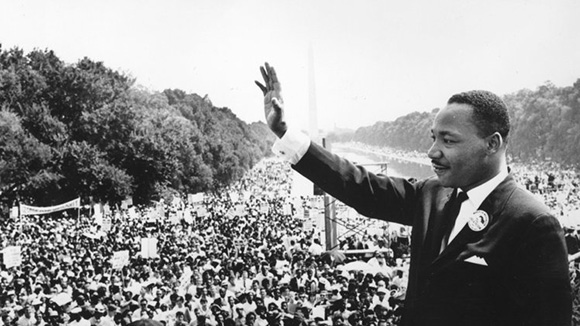
Today, in the wake of the Civil Rights Movement, legal desegregation and voting rights will not be officially abolished, but the plague of “Voter ID” laws and voter registration restrictions is nothing more nor less than a campaign to reinstitute white supremacy, with lying rhetoric about “our colorblind society” in place of the white sheet masks of yesteryear. Economic inequalities and lack of opportunity for Black America, both North and South–which was as central to the 1963 March on Washington as the dismantling of southern segregation–are as embedded in today’s capitalist society as then for tens of millions of African Americans, despite the growth of the Black middle class and professional layers.
While this year’s march has received critical commentary for being a tightly controlled and politically constrained affair–no criticism of president Obama or attorney general Holder allowed!–it should also be remembered that the 1963 March itself was hardly free of contradictions.
The John F. Kennedy administration, to which the Civil Rights Movement looked for legislation, was escalating U.S. intervention in Vietnam toward the catastrophe it would soon become. The leading organizer of the March, the justly praised Bayard Rustin, was himself on a trajectory to become a pro-war Social Democrat and supporter of Lyndon Johnson’s and Richard Nixon’s Vietnam horrors. On the podium, the Justice Department controlled the sound system and was prepared to pull the plug at any mention of “insurrection.” The United Auto Workers leadership of Walter Reuther, prominent supporters of Civil Rights in society at large, contentedly accepted an apartheid-like job reservation system in the plants, unable to imagine that it would fuel Detroit practically burning down four years later.
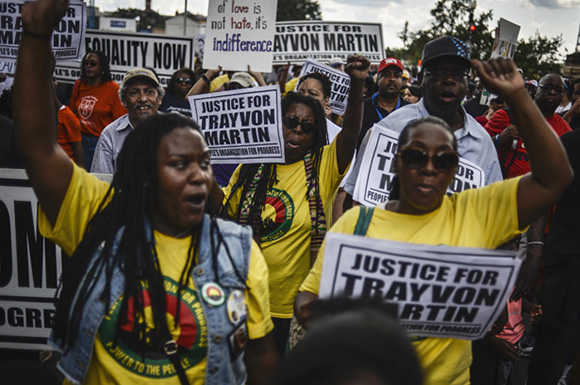
Malcolm X at the time famously denounced the whole event as a picnic and a farce. Yet not long afterward, as Malcolm broke with the sectarian abstentionism of Elijah Muhammad’s Nation of Islam, he would reexamine his views and take a more welcoming view of the Civil Rights Movement, seeing it as it really was: above all, a mobilization of the Black community standing up for itself and prepared to confront brutal repression. America in 2013 is not what it was in 1963, just as 1963 was not 1913 or 1863. But the necessity of a mass mobilization to preserve what’s been won, and to extend it, is equally urgent.
Let’s view the August 24 March as part of that re-mobilization. And let’s not forget some of the positive changes that have occurred. In 1963, Bayard Rustin with all his organizing genius remained in the background, because he was gay. This year, one speaker after another voiced support of the LGBT movement as part of the civil rights struggle. In 1963, no one thought to speak about immigrant rights. In 2013, immigration reform was proclaimed from the podium as a central part of the overall struggle. If the arc of history bends positively, it’s only because mass social movements, with all the imperfections and limitations that will always exist when millions are in motion, push it that way.
The following are observations collected from a few of the Solidarity members who were present at either the 1963 March or the recent demonstration commemorating that event.
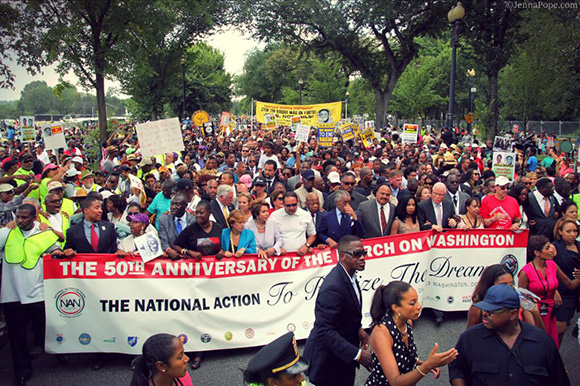
David McCullough (Atlanta):
“In August, 1963 I was in Washington where I grew up, on the way back to Berkeley after a year of graduate study abroad. My parents, government workers like so many in Washington, were very nervous about the demonstration, as if it could lead to riots. All Washington was closed down that day. The government shut all office buildings; everyone stayed home, as the new media urged them to do. Thus it was a piece of cake to catch a bus down to the Mall and join in. The roads were empty.
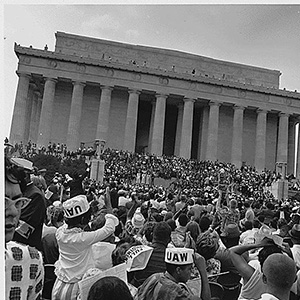 I wandered around the Lincoln Memorial, where the speeches were to be. Down Constitution Avenue came the main line of march. I was impressed when I saw someone I thought was Jackie Robinson, the baseball star, in the front lines. That made it clear, in my mind, that this was both a huge occasion and a mainstream event. Those who shunned the march simply misunderstood a moment of their own history.
I wandered around the Lincoln Memorial, where the speeches were to be. Down Constitution Avenue came the main line of march. I was impressed when I saw someone I thought was Jackie Robinson, the baseball star, in the front lines. That made it clear, in my mind, that this was both a huge occasion and a mainstream event. Those who shunned the march simply misunderstood a moment of their own history.
Having no politics nor affiliation with any group, I looked around for some shade and found a group of young people under the trees whom I could relate to. They were lively and serious at the same time, singing and speaking out. They were SNCC kids from the South. Compared to the churchy and respectable masses, they seemed hip and committed.
I moved close to the Memorial for the speeches, only a couple of which rang a bell – Martin Luther King’s and one of the young leader’s, maybe John Lewis. More memorable was crossing arms and singing civil rights anthems with thousands of strangers, a big step in anyone’s life on the way to collective action.
After the march, I was invited by an old college friend to have a beer with someone she knew, an African-American government official, fairly high up, at his home off 16th street. This gentleman opened my eyes to some things, such as the pervasive segregation of housing in Washington. My family lived a couple of miles away on the other side of Rock Creek Park, but this man could not buy a house on that side of town. The best he could do was where he was.
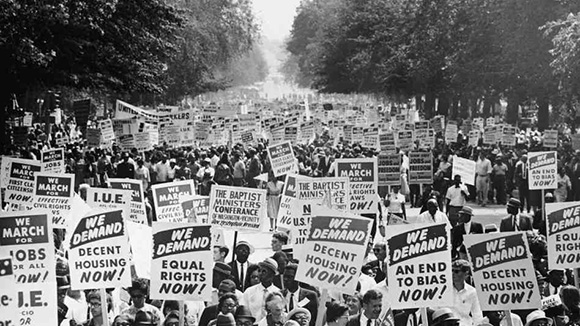
One thing that was clear from the March on Washington was that the people — those marchers were clearly the ordinary people of America — and the government lived in different worlds. It was that way then and is that way today.”
Karin Baker (Western MA):
“I appreciated the large number of people who were motivated to come out to the event, and the composition of the crowd (which was at least 90% people of color). Attendees were energetic and seemed to be celebrating the moment. The tone from the organizers and speakers may have been liberal, but I noticed pockets of militancy from BAMN (By Any Means Necessary), Dream Defenders, and some speakers, including a young Filipina immigrant speaker. I also noted the visible presence of t-shirts and posters reflecting concern about both Trayvon Martin and voting rights; there seemed to be a general awareness of pressing issues and the need for organizing and action. The overall level of organization of the event was also impressive.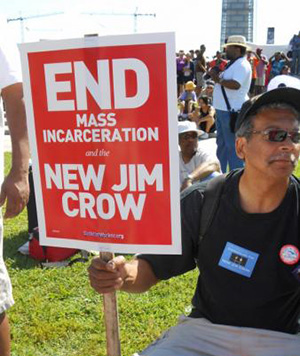
I was concerned, however, by some other aspects of the event. Unfortunately, many of the speakers seemed wrapped up legislative solutions to problems, and they repeatedly encouraged the crowd to pressure legislators and mobilize voter turnout. Maybe this was predictable, but more discouraging was the enthusiastic response these kinds of comments got from the crowd. There also just seemed to be a general lack of focus in the crowd, and occasionally a sense of complacency about what has been accomplished since 1963; this was balanced by the equally strong presence in parts of the crowd about the issues mentioned above, but it was still unfortunate to see that the urgency and militancy was not more widespread.”
Dianne Feeley (Detroit):
“I thought the August 24th March on Washington was an incredible demonstration for civil rights and unity in the face of the neoliberal agenda. In terms of estimating the crowd, I see the media plays it safe in saying tens of thousands. I thought it was about 250,000. Michigan alone chartered 150 buses!
I was impressed by the crowd. African Americans made up about 75%, with union contingents bringing a significant number of Latinos and whites. Contingents from the Black community included the historically Black colleges, fraternities and sororities, Black churches as well as the National Action Network, the NAACP, the Urban League and the Coalition of Black Trade Unionists. The UAW turned out massively and provided marshals in the Metro stations and at the entrances of the Mall to direct people. Other unions I noticed because of their sea of T-shirts or because of their banners and signs were SEIU, health care workers, teamsters and the building trades, including LUNA. Many people came with their families. There was a sprinkling of Quakers, environmental activists, Planned Parenthood and local peace centers.
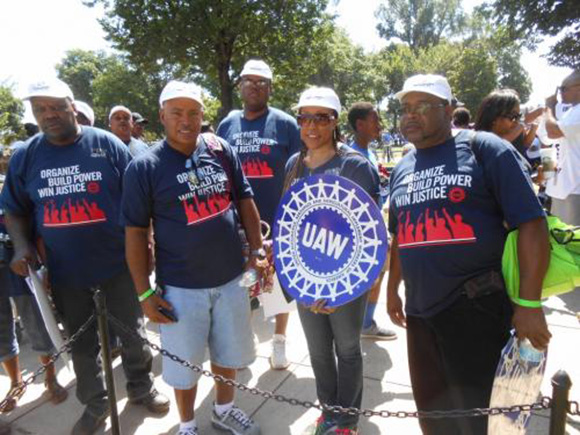
UAW members at the march. Photo by Dan La Botz.
I made a point of speaking with a number of people I met at the march and on the way there and back and would like to share some of what those people talked about:
Douglass, who is vice president of a local NAACP chapter, came to the march with his wife and three-year old son. He felt it was important to be at this historic civil rights event and was happy at the enormous size of the crowd. Even though his son might not remember being there, he felt it would be important that later on in life he would realize that his parents had taken him to the march. Douglass saw the 50th anniversary as a massive show of solidarity against a system that used racism, sexism and classism to reinforce inequality. His hope was that not only would people be able to come together and better understand the interrelated problems, but begin to come up with solutions. He felt the division between the rich and poor was widening. When I asked what he saw as the most important issues to address, he named jobs and health care. He also noted that many people have low-wage jobs so their families are living below the poverty level. This also means they are cut off from adequate health care.
Dorothy, a retired state worker from Detroit, decided to come to the march because she feels the corporations have taken over public life, including the Supreme Court. She pointed to how every public institution in the city of Detroit has been taken over by a state-appointed official who will privatize and sell off the city’s assets. The only tool left is to mobilize people in defense of rights. She feels very strongly that the younger generation is able to get out information over the internet—a kind of people’s version of the rightwing think tank ALEC!
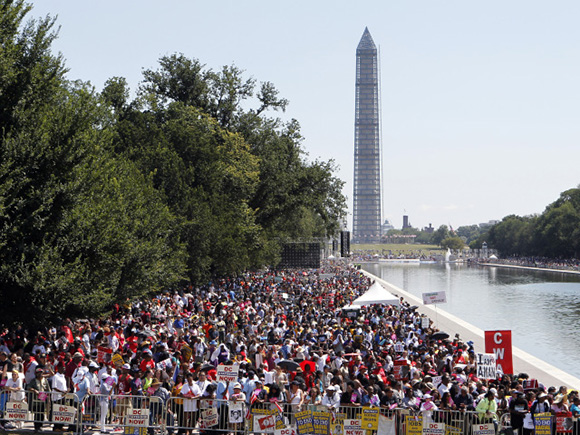
Photo copyright Jon Elswich, AP.
Thelma, 69, came with her granddaughter. She said she’d almost made it to the original march when her church organized busses, but her father didn’t feel comfortable with letting her go. This time she was determined to be there, and to take her granddaughter. As a retired federal worker, she pointed to how many changes have occurred over the last fifty years. When she was in high school, few African Americans had government jobs, except if they were elevator operators or worked in the mail room. But even though there has been change, she still felt Blacks were not being given the opportunity to acquire jobs skills or get prized internships that could lead to good jobs. Emphasize ding the importance of jobs for the Black community; she identified the need for affirmative action. She also felt it was central to expose problems women faced at work and pointed to the recent revelations of rape within the military, which she saw as the tip of the iceberg.
Alexa, 16, came with her grandmother on the Metro from Northeast DC. Alexa felt it was important to celebrate the Black community’s civil rights history. She had talked with her friends about the murder of Treyvon Martin and felt it was definitely racially motivated. Had he been a white teenager, he would not have been killed.
Byran, an African-American teenager from the Detroit area about to go to college—perhaps to study nursing–rode to the march on the National Action Network bus with his mother. He wanted to be at the march in order to be in touch with his culture and to experience a “coming together” of people around problems in a positive setting.”
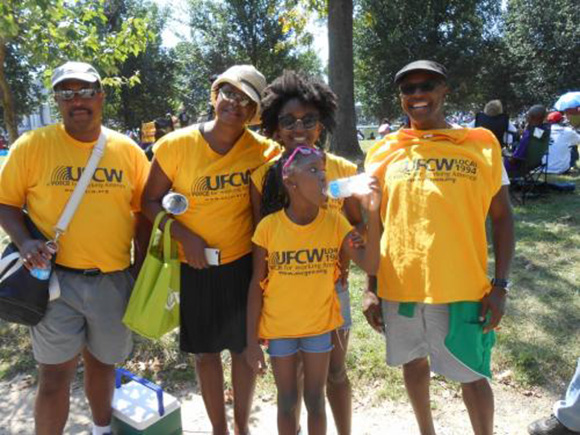
UFCW members at the march. Photo by Dan La Botz.
Dan La Botz (Cincinnati):
[Note: Dan’s comments here were first published as an article on the New Politics website.]
“The Fiftieth Anniversary March on Washington for Jobs and Freedom on August 24 was a mostly African American working class event of tens of thousands. They came to celebrate the struggles and victories of a half century ago and to put on the agenda for today the issues of racial profiling and stand-your-ground laws, the country’s unemployment rate and growing economic inequality, and new restrictions on voting rights. Some of those on the dais before the magnificent Lincoln Monument, like Representative John Lewis, had spoken there in 1963, while others like Newark Mayor and New Jersey Senate candidate Cory Booker were, as he said, not even born then. Where fifty years ago the civil rights leaders had come to implore the Democratic Party politicians, at this march the Democratic Party politicians came to try to mobilize politically—and immobilize socially—their ever more discontented if still incredibly loyal base.
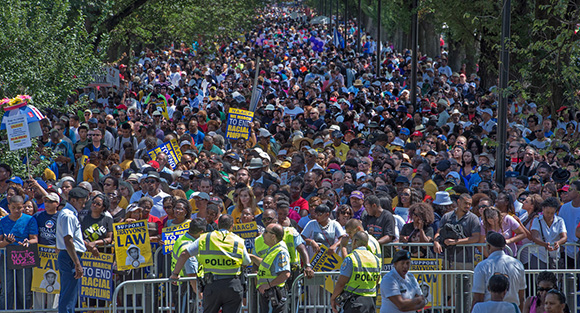
Photo by Paul J. Richards.
The presence on the platform of key figures of the Obama administration, such as Eric Holder, and of the leading Democrat in Congress, Nancy Pelosi, gave the event a quasi-official character in stark contrast to the 1963 march that maintained its distance from the administration by having no political or governmental speakers. While many in the crowd of the 50th anniversary march have good reasons for feeling frustration and anger about government policies and the state of the country, the tone of the event was one of pride in black struggles of the past and pleasure in being present with tens of thousands of others like ourselves who believe in a more democratic, just and decent society. The rally and march, however, did not create the impression that a new movement was being launched, as I had hoped it might, though it did at least show that the unions and civil rights organizations still exist and can still march to the capital to petition for jobs and justice.
The words one saw most often and the most common image was Trayvon Martin, the young man’s whose death has made him the symbol of racial profiling and persecution, killed for no good reason, his killer set free by a system that simply cannot respond with justice to the murder of a young black man. Trayvon was everywhere, on caps and t-shirts, on placards and banners. Many of those present had no doubt participated in protests of the verdict of not guilty in the trial of Martin’s killer George Zimmerman or in protests against stop-and-frisk policies in New York, but those activists did not set the tone for the 50th anniversary march.
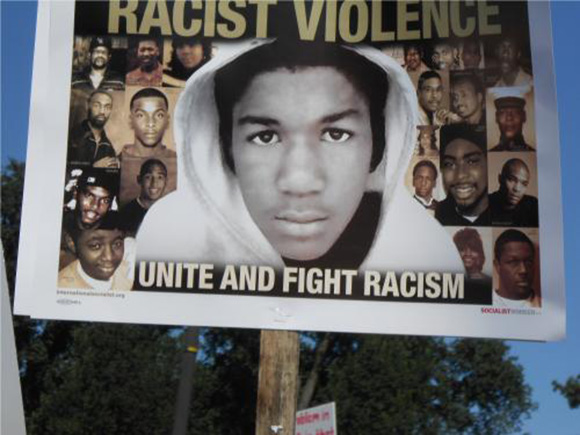
Photo by Dan La Botz
While there were clusters of militants here and there, the crowd had been brought to Washington by the labor unions and the African American civil rights organizations, such as the National Association for the Advancement of Colored People (NAACP) and the National Action Network (NAN) who place their hopes in the Democratic Party to solve their problems. Not surprisingly given the makeup of the crowd, there were no signs and banners criticizing President Barack Obama or his policies. On the contrary, the crowd cheered loud and long for Nancy Pelosi, the Democratic Party’s House minority leader, herself a veteran of the 1963 march. The union members who were there clearly took pride in following in the footsteps of those who came before, but one had little sense that they had come to open new paths to the Promised Land.
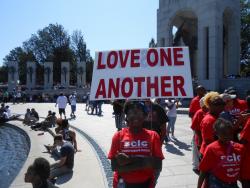 I have seldom been in a mass political demonstration of hundreds of thousands where one felt such fellowship and good will. This was more a picnic in the park than a protest against the powers. If there was no militancy in the rally and the march, there was a great sense of pride and common purpose: these were people who want the country to be better, are willing to work to make it so, and are prepared themselves to shoulder their portion of the burden, and more. Yet, in a certain sense, that was the problem. While people spoke out against racial injustice, there was no sense of a rejection of either the corporations or the government and its policies.. With the exception of small numbers of radicals and socialists, the march saw itself as influencing the system—not challenging it.
I have seldom been in a mass political demonstration of hundreds of thousands where one felt such fellowship and good will. This was more a picnic in the park than a protest against the powers. If there was no militancy in the rally and the march, there was a great sense of pride and common purpose: these were people who want the country to be better, are willing to work to make it so, and are prepared themselves to shoulder their portion of the burden, and more. Yet, in a certain sense, that was the problem. While people spoke out against racial injustice, there was no sense of a rejection of either the corporations or the government and its policies.. With the exception of small numbers of radicals and socialists, the march saw itself as influencing the system—not challenging it.
The left was present, of course. The Democratic Socialists of America (DSA) had endorsed it, and at the rally one saw banners of the Communist Party and the Socialist Party and a spirited march of a few hundred against the new Jim Crow led by the International Socialist Organization. While the ANSWER Coalition and the ISO had printed thousands of placards that one saw scattered throughout the crowd, those who carried them did so because they supported the slogan “Dr. King’s Legacy: Jobs not War” or “End Mass Incarceration and the New Jim Crow,” not because they supported socialism. We on the left were a drop in the bucket of the sea of black working people who continue to place their hopes on making the system work, rather than on the hope of creating a new system.
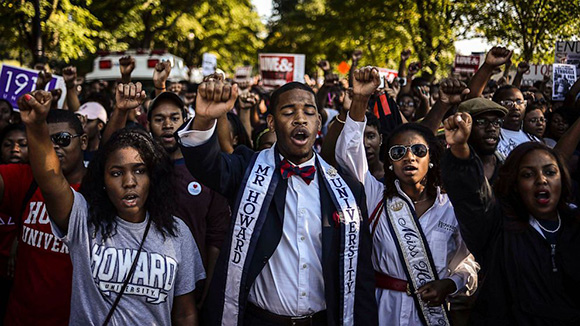
Photo by James Lawler Duggan, Reuters.
Yet all the problems remain, not only the injustice of the justice system, but also the continuing economic problems of high unemployment and growing inequality as well as the attack on voting rights. Health care remains an issue, for Obama Care (never really what we needed) has not yet come and will not come to many states; the public schools and teachers remain under attack; the immigration issue remains unresolved; and everywhere American working people face the government’s austerity program, cutting public services and public employees. The military interventions continue and threaten to expand and the national security state continues to grow, eavesdropping on millions. The Democrats on the dais stand on the wrong side of almost all of these issues, their only real concern to protect voting rights because the Republican attack on their voters endangers their political positions.
This massive March for Jobs and Justice fifty years later was a missed opportunity to launch the movement we so badly need. Yet we can count on the irrationality of the economic system, the unfairness of the political system, and the continuing desire for justice on the part of all of those walked in Washington to give us one more chance. Let it be soon, for every day that passes there is another Trayvon somewhere, another foreclosure, another unemployed worker, another homeless family on the street. Let it be soon, and when it comes, let it be powerful and ‘Let justice roll on like a river, righteousness like a never-failing stream!’”
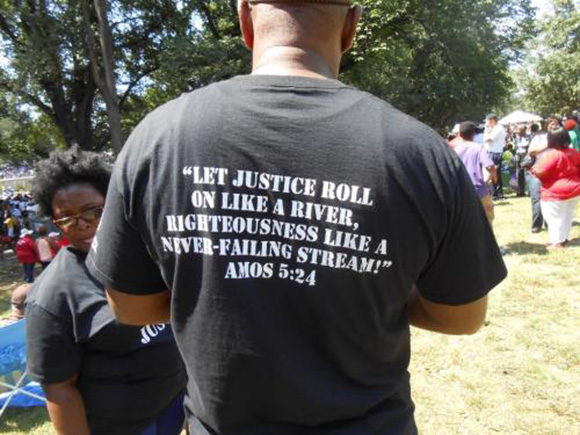
Photo by Dan La Botz.

Comments
One response to “Solidarity Members Reflect on the Anniversary of the March on Washington”
Labor Day Reflections, 2013
by Howie Hawkins
On Labor Day, it is once again an appropriate time to ask the questions we asked leading up to the Aug. 27 community forum in Syracuse on the 50th Anniversary of the 1963 March on Washington for Jobs and Justice.
Why progress on civil rights and economic justice stalled and reversed since the demands of the 1963 March on Washington were made?
Organized by the Syracuse Greens, the community forum was entitled, “The Unfinished March: Where Do We Go From Here?” Southern civil rights movement veterans Colia Clark and Rev. LeRoy Glenn Wright and a Teamster leader in black and left labor organizations, Chris Silvera, offered their perspectives at the forum, followed by an open discussion.
I will give my answer to the question below, but first let’s review at the facts of stall and reversal on the economic and civil rights demanded by the 1963 March.
THE RIGHT TO VOTE 1963 – Voting Rights Act passed in 1965. 2013 – U.S. Supreme Court strikes down key provisions of to the 1965 Voting Rights Act on June 25. Several states immediately enact laws to suppress voting.
THE RIGHT TO A JOB 1963 – A federal program to guarantee the right to a job. Unemployment is 5.4%. Black/White Unemployment Ratio: 2.2 to 1 2013 – A full employment program has not even been considered in Congress since the 1970s. Unemployment is 16.2% (counting involuntary part-timers). Black/White Unemployment Ratio: 2.1 to 1.
THE RIGHT TO LIVING WAGES 1963 – A $2 minimum wage, or $15.27 in August 2013 dollars. 2013 – A $7.25 federal minimum wage.
THE RIGHT TO QUALITY INTEGRATED SCHOOLS 1963 – 76.6% of black children in majority black schools. Black majority schools get less funding. 2013 – 74.1% of black children in majority black schools. Black majority schools still get less funding.
While I heard a few references to the need for jobs, higher wages, and good schools, unlike the 1963 March, no demands were made on the federal government by the recent 50th Anniversary commemorations in Washington DC. Instead of demands on the government, Democratic leaders were put on the podium. At the Labor Day March today at the New York State Fair, none of the speakers, among the Democratic office holders, even referenced the 1963 March or raised any demands.
I think the reason progress stalled and began to reverse in the 1970s is that the movement has been co-opted into the Democratic Party, one of the two wings of the ruling two-corporate-party system. The progressive movement stopped speaking and acting for itself independently of the two-corporate-party system and the organized labor bureaucrats since the 1963 March.
In 1963, the dynamic was very different. The initiative and power came from outside the two parties and the labor bureaucracy. A. Philip Randolph, the principal conceiver, and Bayard Rustion, the principal organizer, of the 1963 March on Washington built that march by relying on their independent organizational bases, namely, the Socialist Party and the black trade union movement, principally Randolph’s Brotherhood of Sleeping Car Porters, but also importantly the black workers’ organizations in other unions, notably the Packinghouse and Autoworkers unions.
To implement the economic demands of the 1963 March on Washington, Randolph led the formulation of a Freedom Budget issued in 1966 to show how Congress could enact full employment, living wages, decent housing for all, universal health care, and integrated quality education for all children.
But then the movement split. Randolph and Rustin chose to rely on the Democratic Party, then in control of both houses of Congress and the Presidency, to implement the Freedom Budget. Despite decades of anti-war activism — Randolph was imprisoned like Debs for opposing World War I, Rustin was imprisoned for refusing to serve in a segregated Army in World War II — they refrained from opposing the escalating Vietnam War in order to maintain ties to the Democratic leadership they were counting on. It turned out that the War on Poverty was lost in Vietnam.
Martin Luther King, Jr., the Student Nonviolent Coordinating Committee (SNCC), and others maintained their independence from the two parties and spoke out and organized against the war. King’s Poor People’s Campaign in 1968 was conceived as a means of winning the Freedom Budget economic demands by independent nonviolent direct action. King intended to direct the unfocused anger of inner city rioting into disciplined nonviolent disruption of business as usual in Washington DC until the economic demands were met.
Unfortunately, after King’s assassination, the broader progressive movement turned away from nonviolent direct action and political independence and largely entered the Democratic Party. No significant progressive economic programs have been adopted since that turn to the Right. Instead, the neoliberal agenda of union busting and low wages, deregulation, privatization, regressive taxation, and trade pacts that enable corporate offshoring has characterized the economic policies of both corporate parties since the 1970s. Wages and living conditions have worsened for the working class majority in America since their peak in the early 1970s.
If working people are going to start winning progressive reforms again, we are going to have to start speaking and acting for ourselves, in elections and on the streets, independently of both the corporate parties and the Democratic lap dogs at the top of the labor bureaucracy.
If you want to read more about what I’ve discussed here, I suggest the following:
Economic Policy Institute’s analysis of where we are on the economic demands of the march, “The Unfinished March:” http://www.epi.org/publication/unfinished-march-overview/
Final Organizing Manual of the 1963 March (with sponsors, call, and demands): http://www.crmvet.org/docs/moworg2.pdf
Two articles on how the 1963 march was organized outside the 2-party system and the AFL-CIO largely by black democratic socialists affiliated with the Socialist Party and predominantly black trade unions: http://prospect.org/article/socialists-who-made-march-washington http://www.labornotes.org/2013/08/how-black-unionists-organized-1963-march-jobs-and-freedom
On Randolph/Rustin/King post-march effort to get Congress to pass programs to realize the economic demands:
Paul LeBlanc and Michael Yates, “Toward a New Freedom Budget: The Day After the March on Washington for Jobs and Freedom,” CounterPunch, Aug. 16, 2013, http://www.counterpunch.org/2013/08/16/the-day-after-the-march-on-washington-for-jobs-and-freedom/
Martin Luther King, Jr. on the consequences of de facto school segregation, speaking at Syracuse University, 1965, excerpted in this Post-Standard column by Sean Kirst with the link to the full speech included: http://www.syracuse.com/kirst/index.ssf/2013/08/president_obama_in_syracuse_a.html
Bill Fletcher on how black labor and economic demands were central to the 1963 march: http://zinnedproject.org/2013/08/the-1963-march-on-washington/
An inteview with Paul LeBlanc that discusses the split between Randolph and Rustin on one side and King on the other concerning Vietnam and independence from the Democrats: http://www.insidehighered.com/views/2013/08/21/interview-paul-le-blanc-freedom-budget-all-americans#ixzz2csEU4cqm
A co-founder of the Clamshell Alliance and the Green Party, Howie Hawkins is a Teamster from Syracuse, New York.